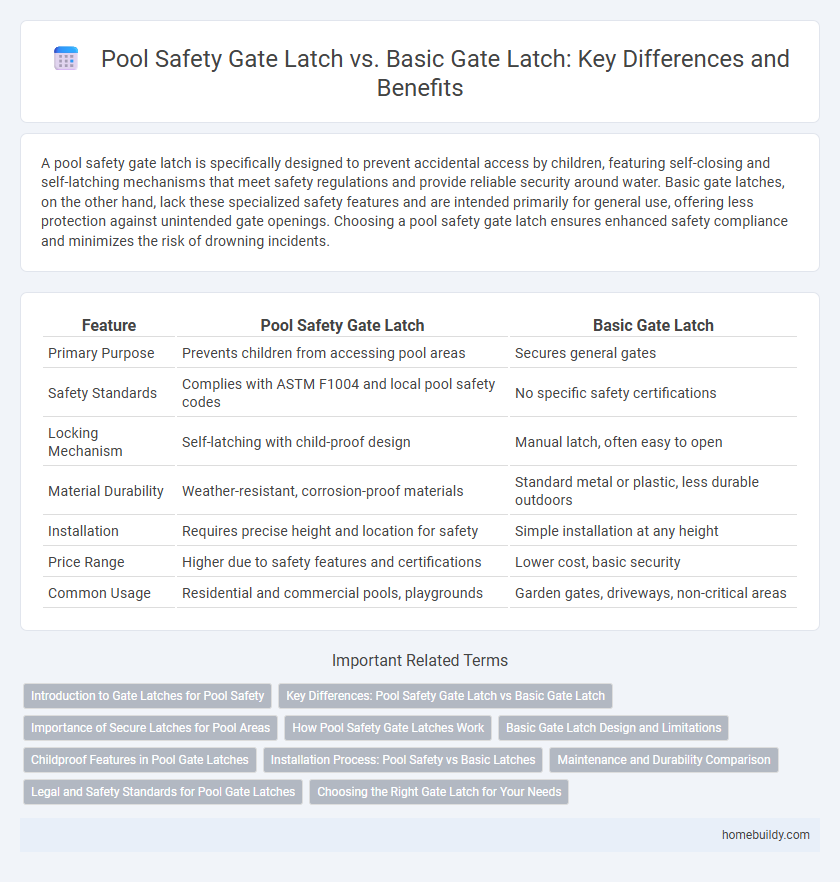A pool safety gate latch is specifically designed to prevent accidental access by children, featuring self-closing and self-latching mechanisms that meet safety regulations and provide reliable security around water. Basic gate latches, on the other hand, lack these specialized safety features and are intended primarily for general use, offering less protection against unintended gate openings. Choosing a pool safety gate latch ensures enhanced safety compliance and minimizes the risk of drowning incidents.
Table of Comparison
| Feature | Pool Safety Gate Latch | Basic Gate Latch |
|---|---|---|
| Primary Purpose | Prevents children from accessing pool areas | Secures general gates |
| Safety Standards | Complies with ASTM F1004 and local pool safety codes | No specific safety certifications |
| Locking Mechanism | Self-latching with child-proof design | Manual latch, often easy to open |
| Material Durability | Weather-resistant, corrosion-proof materials | Standard metal or plastic, less durable outdoors |
| Installation | Requires precise height and location for safety | Simple installation at any height |
| Price Range | Higher due to safety features and certifications | Lower cost, basic security |
| Common Usage | Residential and commercial pools, playgrounds | Garden gates, driveways, non-critical areas |
Introduction to Gate Latches for Pool Safety
Pool safety gate latches are specifically designed to meet strict safety standards, featuring self-closing and self-latching mechanisms to prevent accidental openings, which basic gate latches typically lack. These latches often include childproof locking systems, enhancing security around pools to reduce drowning risks. Pool gate latches must comply with regulations such as ASTM F1004 and UL 325, ensuring reliable performance in high-risk environments.
Key Differences: Pool Safety Gate Latch vs Basic Gate Latch
Pool safety gate latches feature self-closing and self-latching mechanisms designed to prevent accidental gate openings, complying with strict safety standards like ASTM F1004 and UL 325. Basic gate latches often lack these automatic features and security certifications, primarily serving simple closure functions without child-proof designs. The key difference lies in enhanced durability and safety compliance of pool safety latches, making them essential for preventing unauthorized pool access and ensuring child safety around swimming areas.
Importance of Secure Latches for Pool Areas
Secure pool safety gate latches are specifically designed to prevent accidental access by children, reducing the risk of drowning incidents around pools. Unlike basic gate latches, pool safety latches often incorporate self-closing and self-locking mechanisms that comply with strict safety standards such as ASTM F1004 and ANSI A117.1. Investing in a certified pool safety gate latch enhances protection by ensuring gates remain reliably closed, safeguarding vulnerable individuals and meeting local safety regulations.
How Pool Safety Gate Latches Work
Pool safety gate latches feature self-closing and self-latching mechanisms that automatically secure the gate after each use, preventing accidental openings and enhancing child safety. These latches often incorporate a release mechanism positioned out of a child's reach, such as a thumb press or a key lock, ensuring only adults can open the gate. In contrast, basic gate latches require manual operation without automatic securing features, making them less reliable for pool safety compliance.
Basic Gate Latch Design and Limitations
Basic gate latch designs typically feature simple mechanical mechanisms such as sliding bolts or lever handles, which provide straightforward operation but limited security. These latches often lack features like childproof locking or corrosion resistance, making them less suitable for safety-critical applications like pool gates. Their minimal design restricts functionality and durability, increasing the risk of accidental openings and compromising pool safety compliance.
Childproof Features in Pool Gate Latches
Pool safety gate latches are specifically designed with childproof features such as high mounting placement, dual-action release mechanisms, and tamper-resistant components to prevent young children from opening gates. Basic gate latches typically lack these safety measures, making them less reliable in securing pool areas against accidental child entry. Investing in a pool safety gate latch ensures compliance with safety regulations and significantly reduces the risk of drowning incidents by restricting unauthorized access.
Installation Process: Pool Safety vs Basic Latches
Pool safety gate latches require a more complex installation process compared to basic gate latches due to stringent compliance with safety standards and childproof mechanisms. These latches often involve precise height placement, secure mounting techniques, and may require tools for proper alignment to ensure tamper resistance. Basic gate latches typically feature straightforward installation, with fewer safety requirements and simpler attachment methods.
Maintenance and Durability Comparison
Pool safety gate latches are constructed from corrosion-resistant materials such as stainless steel or heavy-duty plastic, ensuring durability against weather exposure and pool chemicals, whereas basic gate latches often use standard metal prone to rust and wear. Maintenance for pool safety latches involves regular inspections and cleaning to prevent buildup that could impair locking mechanisms, while basic latches typically require more frequent repairs or replacements due to lower durability. The enhanced resilience of pool safety latches contributes to long-term reliability and consistent safety performance in outdoor, moisture-rich environments.
Legal and Safety Standards for Pool Gate Latches
Pool safety gate latches must comply with strict legal and safety standards, including ASTM F1004 and local building codes to prevent accidental drowning, whereas basic gate latches often lack these certifications. Certified pool gate latches feature self-closing and self-latching mechanisms, child-resistant releases, and placement at a minimum height of 54 inches for enhanced security. Failure to install compliant pool gate latches can result in legal penalties and increased liability for property owners.
Choosing the Right Gate Latch for Your Needs
Pool safety gate latches feature self-closing and self-latching mechanisms designed to prevent accidental access, meeting strict safety standards such as ASTM F1004 and UL 1034. Basic gate latches usually lack these safety features, making them unsuitable for childproof environments or regulated areas. Choosing the right gate latch depends on the intended use, prioritizing safety compliance, durability, and ease of use for pool environments.
pool safety gate latch vs basic gate latch Infographic

 homebuildy.com
homebuildy.com